The Dalai Lama turned 79 this week, entering his 80th year on July 6. This ICT report focuses on the 2.65 m yuan ($427,454) renovation of his birthplace and the dramatic transformation of the area where he lived as a child.
This report also presents new information and images of the birthplaces of the previous incarnations of the Dalai Lama in the context of shifting political considerations by the Chinese authorities, both at the national and local levels.
- The Chinese authorities seek to represent the renovation of the 14th Dalai Lama’s birthplace, and restoration work on other homes of earlier Dalai Lamas, as an assertion of control and ‘ownership’ of the Dalai Lama lineage. This is linked to Beijing’s objectives of controlling and managing the successor of the Dalai Lama, notably involving new measures imposed by the atheist Party state aiming to ensure that Tibetan lamas could only be reincarnated with the permission of the government.[1] The Beijing leadership takes the enduring influence of the Dalai Lama seriously and in recent years has stepped up its efforts to strengthen its position as the ‘official’ arbiter of Tibetan Buddhist culture.
- Consistent with this approach, the Chinese authorities have referred publicly to their imperative of ‘recovering’ the home of the Sixth Dalai Lama, situated outside Tibet in the sensitive border area of Tawang, Arunachal Pradesh, India, which Beijing claims as part of the People’s Republic of China (PRC). A state media report stated the authorities’ intention if not to ‘recover’ the entire territory, “at least, the birth place of the Sixth Dalai.”[2]
- The official recognition and funding for the childhood homes of the Dalai Lamas, particularly the 14th, is even so an implicit acknowledgement of the central role of the 14th Dalai Lama not only in Tibet’s history but also in the present-day, despite the Chinese Party state’s aggressive anti-Dalai Lama campaign. “Politically, the Chinese authorities condemn the Dalai Lama. But inside Tibet, they know they can’t ignore him,” said a Tibetan researcher from Amdo who is now in exile.
- Through emphasizing multi-million yuan projects such as the renovation of birthplaces and temples associated with the current and previous Dalai Lamas, the Chinese authorities aim to convey the message that they are protecting Tibet’s heritage. In exile, the Dalai Lama has described systematic policies and practices of cultural repression and destruction in Tibet as “a sort of cultural genocide”.[3] In several of the Dalai Lamas’ birthplaces, there is the added irony that the renovation now being promoted by the authorities is due to earlier destruction during the Cultural Revolution, and would not have come about without determined efforts of local Tibetans to protect their religious and cultural sites.
- The Chinese authorities have implemented dramatic redevelopment in and near the remote village and house where the current, 14th, Dalai Lama was born on the eastern edge of the Tibetan plateau as part of ambitious economic plans for the area.
- In contrast to the attention given to the 14th Dalai Lama’s birthplace by the Chinese Party state, the homes of earlier Dalai Lamas in different parts of Tibet are mostly less politically sensitive and in most cases low-profile and little-known. But a number of them, such as the birthplaces of the 13th, 11th and Seventh Dalai Lamas, have been subject to renovation and are still visited by pilgrims.
- The status of the Dalai Lamas birthplaces as tourist attractions is ambiguous; while the current Dalai Lama’s childhood home appears in some Chinese-language tourist brochures, access for foreigners is patchy and sometimes restricted.
Map of birthplace locations
[mgl_gmap mapid=”HHDL” lat=”34.373515″ long=”102.048608″ zoom=”5″ width=”100%” height=”450px” skin=”retro” controls=”pan,zoom,scale,streetView,overviewMap,scrollWheel” ][mgl_marker lat=”28.948711″ long=”88.586237″ icon=”https://savetibet.org/wp-content/uploads/2014/07/hhdl-012.png”]Gedun Drupa (1391-1474)
Shabtod, near Sakya, now Shigatse (Chinese: Rigaze), Tibet Autonomous Region (formerly U-tsang)
[/mgl_marker][mgl_marker lat=”29.258286″ long=”88.903467″ icon=”https://savetibet.org/wp-content/uploads/2014/07/hhdl-02.png”]Gedun Gyatso (1475 – 1542)
Tanag Segme (U-tsang); present-day Shigatse, Tibet Autonomous Region
[/mgl_marker][mgl_marker lat=”29.646923″ long=”91.005975″ icon=”https://savetibet.org/wp-content/uploads/2014/07/hhdl-03.png”]Sonam Gyatso (1543 – 1588)
Tolung (U-tsang), present-day Toelung Dechen, Tibet Autonomous Region
Mongolia 
Chingwar Taktse, Yarlung Valley (U-tsang), present day: Chonggye County (Chinese: Qiongjie),
Lhokha Prefecture (Chinese: Shannan) TAR Tibet Autonomous Region
Mon Tawang, Arunachal Pradesh, India
Lithang (Chinese: Litang), Kardze (Chinese: Ganzi) Tibetan Autonomous Prefecture, Sichuan, the Tibetan area of Kham
Thobgyal (U-tsang), Shigatse, Tibet Autonomous Region
[/mgl_marker][mgl_marker lat=”31.518301″ long=”98.230859″ icon=”https://savetibet.org/wp-content/uploads/2014/07/hhdl-09.png”]Lungtok Gyatso (1805 – 1815)
Dan Chokhor (Kham), present-day Sichuan
[/mgl_marker][mgl_marker lat=”30.235972″ long=”100.197412″ icon=”https://savetibet.org/wp-content/uploads/2014/07/hhdl-10.png”]Tsultrim Gyatso (1816 – 1837)
Lithang, Kardze (Kham)
[/mgl_marker][mgl_marker lat=”29.936528″ long=”102.213403″ icon=”https://savetibet.org/wp-content/uploads/2014/07/hhdl-11.png”]Khedrup Gyatso (1838 – 1856)
Gathar, Kham Minyak (Kham), near present-day Dartsedo (Kangding) in Sichuan
Lhoka (Chinese: Shannan), Tibet Autonomous Region
Dagpo Langdun (U-tsang), Tibet Autonomous Region
Taktser, Kumbum (Amdo), present-day Qinghai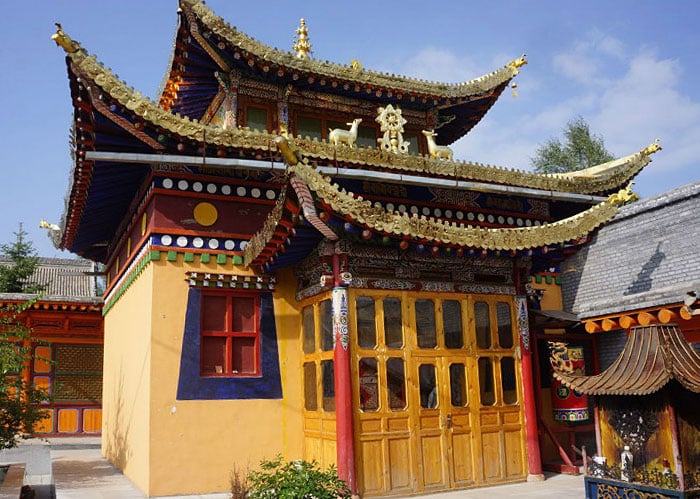
Renovation and urbanization of Dalai Lama’s birthplace area reflects China’s political priorities
The extensive renovation[4] of the current Dalai Lama’s birthplace in Taktser (Chinese: Hong’Ai), in the Tibetan area of Amdo, which at the time was under the control of a Chinese Hui (Muslim) warlord,[5] and has since been incorporated into the PRC’s Qinghai Province,[6] has taken place in the context of rapid urbanization in his home area.
While the refurbishment took place, the house, built in traditional style around a central courtyard, was surrounded by a three-meter high boundary and security cameras were installed.
Now that the renovation is complete, the building and its surroundings are scarcely recognizable from the small farmer’s dwelling found by a search party of Tibetan lamas who identified a two-year old boy called Lhamo Dhondup as the Dalai Lama’s reincarnation in the 1930s. In 1937, when the Dalai Lama was a toddler, his parents were Tibetan farmers, subsisting on cultivation of barley, potatoes and produce from yaks, hens and sheep.
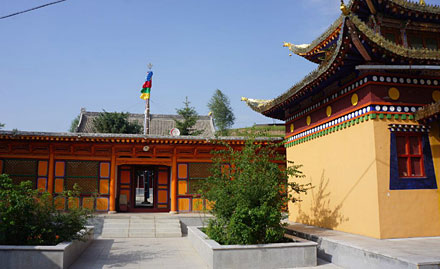
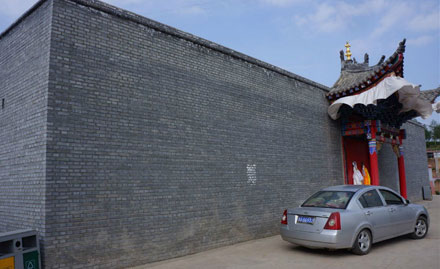
According to the Chinese state media, $2.65 million yuan ($427,454) was allocated for the renovation and rebuilding of this rural village, constructing new houses, roads, shops, a sewage treatment plant and drinking water facilities at Taktser.[7] The village was promoted in the state media as a positive example of the provision of housing and fast-track urbanization: “More than 70 years after the Tibetan spiritual leader left, Hong’Ai is at the front of China’s massive drive to raze shanties and build safe, modern homes for the poor rural residents of the region.”[8] This was the second time for some inhabitants that their houses had been razed; for some, it had happened during the Cultural Revolution.
Urban development in Ping’an county has proceeded at a dizzying pace, and the Chinese authorities announced last year that the county where the village is located, Ping’an County in Haidong (Tibetan: Tsoshar) Tibetan Autonomous Prefecture, will be absorbed into a new city to be given the name of the prefecture, Haidong. (Xinhua, May 17, 2013).[9]
The county town of Ping’an (Tsongkha Khar in Tibetan), which is around 20 minutes drive to the Dalai Lama’s birthplace, is being transformed into an industrial city with a focus on developing ‘high-tech industry’ and boosting infrastructure construction.[10]
A foreign visitor to Ping’an in May 2014, told ICT: “Passing through Ping’an today one can see miles and miles of Chinese-style high-rise apartment construction. There’s very little visible sign that this is a Tibetan area, and the sheer scale of construction is more reminiscent of large Chinese cities in the interior than it is of anywhere else on the Tibetan plateau. Because it’s so close to Xining, it seems like it could very easily become a satellite city which retains almost none of its Tibetan heritage.”
A new bullet train that climbs hundreds of meters onto the Tibetan plateau to speed through Qinghai, passing near the Dalai Lama’s birthplace, is due to open later this year. The line, that has been dubbed the ‘high speed Silk Route’, will link the capitals of Gansu province and Xinjiang (East Turkestan). The 1,776-km long project, due to be completed this year, is the longest high-speed railway under construction in the world and the first in China to be built partly across a plateau.[11]
The expansion of the rail network in Tibet along with the rapid and large-scale development of mineral and hydropower resources across the plateau are key elements of China’s centrally planned development targets for Tibet, and also essential to the development of tourism.
‘The mountains are too high and the road is too long’[12]
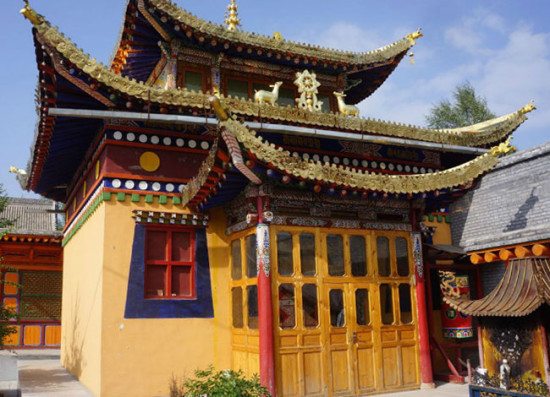
|
Taktser village is still slightly off the beaten track in a predominantly rural area on the route from Xining, the provincial capital of Qinghai, to Labrang Tashi Khyil, one of the most important Tibetan Buddhist monasteries in the area.
While a simple marker stone within the house in Taktser shows where the Dalai Lama was born, once a cow-shed behind the main dwelling, the house itself is a reconstruction. It was first built in the early 1950s by the Tibetan authorities in Lhasa as a new version of the simple farmer’s dwelling where the Dalai Lama’s parents lived. Following the destruction of this building during the Cultural Revolution by Red Guards, it was first rebuilt in the years of relative liberalization in the 1980s.
As with other Dalai Lama birthplaces, the Chinese authorities directly claimed credit for the renovation in 1986, stating that they invested nearly 380,000 yuan ($61,290) in rebuilding his former residence, 27 years after he went into exile. (Xinhua, March 10, 2011). The state media article sought to give the impression of a generous benefactor, stating that it had funded the renovation even “Although the Chinese government has lambasted the Dalai Lama’s ‘attempts to separate Tibet from China’.” The same Xinhua article also acknowledged funding from the Dalai Lama’s nephew, Gonpo Tashi, who had contributed thousands of yuan to the renovation.
The birthplace is referenced in some Chinese-language tourist brochures available in Xining, along with Kumbum monastery, a bird sanctuary at Kokonor Lake, and the late 10th Panchen Lama’s birthplace, also in Amdo.[13] But at the same time access to foreigners, sometimes even Chinese tourists, is patchy and sometimes restricted.
British journalist and author Isabel Hilton, who visited Taktser as part of her research on a book about the Panchen Lama, wrote: “The leader of Tibetan Buddhism, according to Beijing, is an enemy of the state, a ‘splittist’, and most bizarrely of all, a man of doubtful spiritual credentials. To have his birthplace become a pilgrimage, as it surely would if access to it was unimpeded, would be deeply embarrassing to Beijing. All this gives the Dalai Lama’s birthplace a somewhat ambiguous status as an official tourist attraction. The solution is to list the village in the guidebooks, but to ensure that it is never ‘convenient’ for anyone actually to reach it.”[14]
Following the protests that swept Tibet in 2008, access to the current Dalai Lama’s birthplace was restricted. An account by a foreign, anonymous blogger from June 2013 recorded how he was told to leave the home during a visit with a Chinese friend, saying: “A group of men on the second floor saw me and gestured brusquely for me to leave. One of them was in uniform, and they were clearly responsible for security. I wasted no time in leaving and going back to the taxi. In the meantime, my friend attempted to argue that as a Chinese she should be allowed in, but they told her that she couldn’t because she was accompanying a foreigner. If she came back on her own the next day, they would let her in.”[15]
Another blogger, author Chris Taylor, recounted in 2013 how despite his attempts at “secrecy and subterfuge” he was not able to make more than a brief visit to the birthplace.[16] Other foreigners visiting at less sensitive periods have experienced no difficulties with access.
A BBC team who visited Taktser in 2008, and were stopped at a checkpoint, were told by locals that Taktser village gets “lots of tourists” who “come in buses”.[17]
While most visitors to the birthplace are Tibetan pilgrims, many Chinese tourists, particularly Buddhists, make the trek to Taktser. A group of Chinese visitors gave this account of their visit in September, 2013, in a blog: “Is there any trace of the Dalai Lama in Taktsar village, we asked each other on the car, but no one could provide an answer. All we really desire is to see what it is looks like now. Eventually, we arrived at an ancient gate next to the road, but there was no sign indicating where the Dalai Lama was born. We drove about 10 kilometers further, asked the villagers on the way about the direction to Dalai Lama’s home, and no matter whether they were old or young, if you said the name of the Dalai Lama, their faces lit up with huge smiles, and they gave us directions. As we drew near, we saw so many traces of Chinese Communist Party leadership. We noticed refurbished houses surrounded by a high wall, with a tightly locked gate and Tibetan khatags [white blessing scarves] hung on the door. This was the Dalai Lama’s home. Some villagers watched us in silence.”[18]
In its original form, the house was a rectangular building with wooden floors, with a flat roof arranged around a wide central courtyard. Over the entrance there was a socket fixed in the roof to take a 10-foot-high flagpole, with a flag inscribed with prayers. In the northern wing was the shrine room.[19]
The Chinese state media acknowledges that the birthplace house has few Tibetan flourishes in the design other than a framed Tibetan painting with both the Chinese and Tibetan characters for ‘Tashi Delek’ a Tibetan greeting, at the bottom.
In a subtle reflection of the fears for Tibetan cultural survival in the area, the Dalai Lama’s nephew, Gonpo Tashi, who still lives and maintains the birthplace of his uncle, was cited by Chinese media as saying that he could have rebuilt the house in traditional Tibetan style with carvings and paintings on the wooden pillars, but that few artists are still capable of such work.
Birthplace of the ‘Great 13th’ Dalai Lama
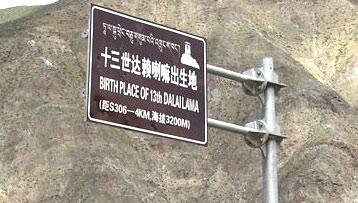
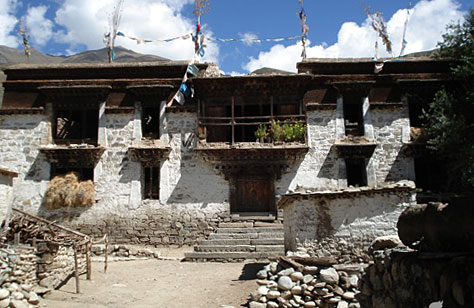 The 13th Dalai Lama, Thupten Gyatso, was born in Dagpo Langdun (U-tsang), Tibet Autonomous Region. Depicted are two images of the birthplace, a sign leading up to it with large Chinese characters, and an old house where the 13th Dalai Lama is believed to have been born. The photographs were uploaded online by the local authorities. |
A prominent signpost with large Chinese characters marks the birthplace south-east of Lhasa of the 13th Dalai Lama, Thubten Gyatso, known as the ‘Great 13th’, a reformer who effectively asserted Tibet’s independence and the Dalai Lama’s temporal and spiritual authority at a critical moment in Tibet’s history. Chinese and Tibetans, particularly those aware of the site’s historic and political significance, still visit the 13th Dalai Lama’s birthplace.[20]
According to Chinese state media and other sources, in the mid- 1990s, local people called upon the government to fund the rebuilding of the birthplace of the 13th Dalai Lama in Dakpo Langdun, in Lhokha (Chinese: Shannan) prefecture in the Tibet Autonomous Region. Substantial parts of the buildings in the area had been destroyed during the Cultural Revolution, and two partial ruined buildings remained, including a tree that was cultivated by the 13th Dalai Lama in his lifetime. It was not until 2004-5 that the local authorities invested in a large-scale renovation of the site over a year, and the birthplace is now discreetly listed in some tourist itineraries for the area.
The 13th Dalai Lama was the first who had to respond to significant pressures on Tibet from outside – from Tsarist Russia, the British Raj (in the form of the invasion in 1904), nationalist China, and finally, the Russian and Chinese Communists.
A Chinese tourist who visited his birthplace in October 2012, revealed a lack of political context common in the perceptions of Chinese visitors who are subject to the representations of the Chinese state on Tibet, in which Britain’s military expedition is depicted as the triumph of ‘China’s Tibet’ over imperialism. In a blog on his visit to the 13th Dalai Lama’s birthplace, the Chinese visitor misrepresented the 13th Dalai Lama’s focus on protecting Tibet’s national identity as merely providing support to Chinese ‘national unity’: “As we approached, we noticed a big signboard which stated in Chinese ‘13th Dalai Lama’s birthplace’. Some of us had already read the history of the 13th Dalai Lama, and in particular his determination to fight British colonialism. The 13th Dalai Lama made a huge contribution to national unity.”
Asserting ownership: the Sixth Dalai Lama’s home in Tawang
The childhood home of the controversial Sixth Dalai Lama, Tsangyang Gyatso, is located in the sensitive border area of Tawang, Arunachal Pradesh, India. The current Dalai Lama sought refuge in the important Tibetan Buddhist monastery of Tawang following his escape from Tibet in 1959.
Following the 1962 border war between India and China, the Tawang area is arguably the most important of 14 still contested sections of the border. In a position that has been countered strongly by the Indian government, the Chinese leadership claims that Arunachal Pradesh is part of the PRC, including on a new map published since Narendra Modi’s takeover as Indian Prime Minister last month.[21]
In an article entitled ‘China will not abandon birth place of Sixth Dalai Lama in Dawang [sic] area’, commentator Liu Silu in the PRC-owned Hong Kong newspaper Wen Wei Po stated that: “Due to special significance of Dawang area, China can never give up the place. However, recovery of the entire 90,000 square kilometers of land will be very difficult. At least, the birthplace of the Sixth Dalai should be recovered. This writer is convinced that China will not give up Dalai’s birthplace now and will never give up the place in the future.”[22]
Birthplaces of the previous Dalai Lamas
The Dalai Lamas are believed to be manifestations of Avalokiteshvara or Chenrezig, the Bodhisattva of Compassion. Bodhisattvas are believed to be enlightened beings who have postponed their own nirvana and chosen to take rebirth in order to serve humanity. The current Dalai Lama is the 14th incarnation.[23]
- Of the 14 Dalai Lamas, two were born outside Tibet – the Sixth Dalai Lama in the sensitive border area of Tawang, now located in Arunachal Pradesh, India, and the Fourth Dalai Lama in Mongolia in 1589.
- The current Dalai Lama is the only incarnation of the lineage to be born in the eastern Tibetan area of Amdo.
- Three of the previous Dalai Lamas, the First, Second, and Eighth, were born in Tsang region in present-day Shigatse in the Tibetan region of U-Tsang, now located in the area incorporated by the PRC as the Tibet Autonomous Region. Tashilhunpo monastery in Shigatse, seat of the Panchen Lamas, was founded by the First Dalai Lama in 1447. The Third, the Fifth (known as the Great Fifth), the 12th and the 13th Dalai Lamas were also born in various areas of U-Tsang, in what the PRC now calls the Tibet Autonomous Region.[24]
- Two of the previous Dalai Lamas, the Seventh and the Tenth, were born in Lithang in the Tibetan area of Kham, now incorporated in Kardze (Chinese: Ganzi) Tibetan Autonomous Prefecture, Sichuan Province.
- At least four of the birthplaces or associated temples of Dalai Lamas have been subject to renovation and redevelopment. These four are those of the current 14th Dalai Lama; the 13th Dalai Lama; the Seventh Dalai Lama, and the 11th Dalai Lama. In the case of the latter two birthplaces, the Chinese state media publicized their efforts to protect these historical sites, describing them as a “major measure” taken to protect Tibetan culture by the Chinese government. The state media reported that under the Qing Dynasty, a manor house was built for the Seventh Dalai Lama, while a nearby temple connected to the 11th Dalai Lama was rebuilt. The same articles stated that the Tawu (Chinese: Dawu, Daofu) government had spent two million yuan on the restoration.[25]
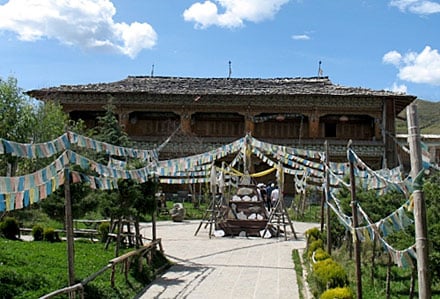
Yonten Gyatso, Fourth Dalai Lama, was born in Mongolia in 1589. The source of the image did not give details about the exact location, but shows a wooden building with a mountainous background.
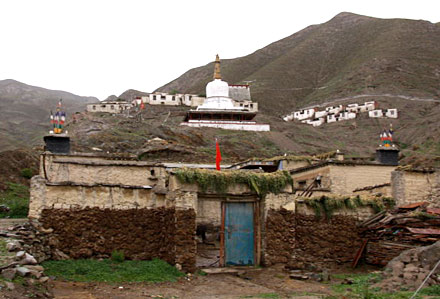
The Great Fifth Dalai Lama, Lobsang Gyatso, was born in 1617 in Chonggye County (Chinese: Qiongjie), Lhokha Prefecture (Chinese: Shannan), Tibet Autonomous Region. The family home of the Fifth Dalai Lama is located next to a monastery.
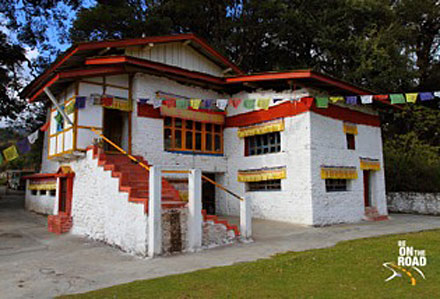
Tsangyang Gyatso (1682 – 1706), was born in Ur-gye-ling, current location, Tawang, Arunachal Pradesh, India. The image shows an isolated and beautiful white-walled house and extensive Buddhist war murals. Compared to the other Dalai Lama birthplaces, it is clear that this residence is outside Tibet, given the freedom to create a space of pilgrimage without restrictions.
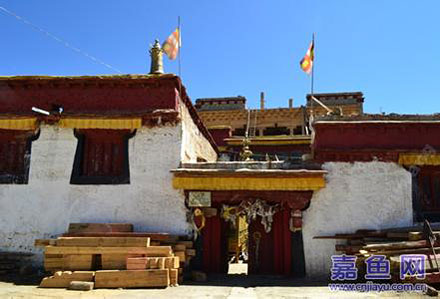
Kelsang Gyatso, the Seventh Dalai Lama, was born in Lithang (Chinese: Litang), Kardze (Chinese: Ganzi) Tibetan Autonomous Prefecture, Sichuan, the Tibetan area of Kham. These two images were uploaded by visitors on social media in July 2012, and show the renovation of the house and its appeal to tourists.
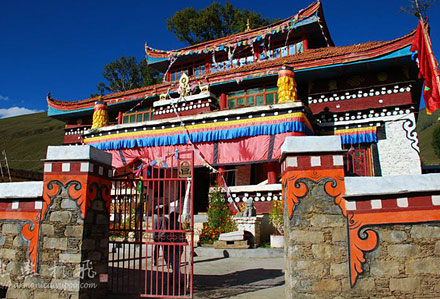
Khedrup Gyatso, 11th Dalai Lama, was born in 1708 in Gathar, Kham Minyak (Kham), near present-day Dartsedo (Kangding) in Sichuan. This images shows the renovated house where he was born. The photos were uploaded by Chinese tourists on social media.
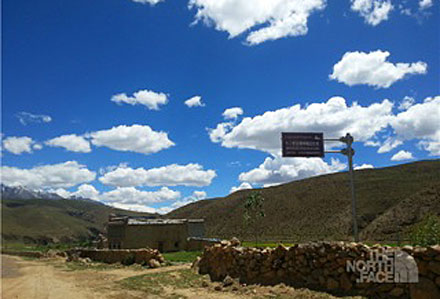
The 12th Dalai Lama, Trinley Gyatso, was born in Lhoka (Chinese: Shannan), Tibet Autonomous Region. The images show the sign near the birth-place, the house itself with prayer wheels. Nearby there is a Chinese national flag, which may be on a local government building. The photo was shared by Chinese tourists.
The 14 Dalai Lamas
The following list is based on information on the Dalai Lama’s official website, www.dalailama.com and ‘The Treasury of Lives: Biographies of Himalayan Region’, a project of the Shelley and Donald Rubin Foundation in New York, and includes contemporary geographical locations.[26]
Alexander Norman, who worked on the Dalai Lama’s autobiography ‘Freedom in Exile’ and is author of a book about the lives of the Dalai Lama, writes: “Strictly, the origins of the Dalai Lamas lie in the 14th century – the First Dalai Lama was born in 1391 – yet the institution did not take its present form until the time of the Great Fifth, whose dates are 1617 – 1682. The first to have been recognized during his lifetime was in fact the Third. On top of all this, the First is himself considered by Tibetans to be 43rd in an unbroken succession of incarnations stretching back into the mists of pre-history.”[27]
| Lifespan | Enthronement | Place of Birth (present day location) |
||
|---|---|---|---|---|
| 1 | Gedun Drupa | 1391-1474 | n/a | Shabtod, U-tsang (Shigatse Prefecture, Tibet Autonomous Region) |
| 2 | Gedun Gyatso | 1475-1542 | n/a | Tanag Segme, U-tsang (Shigatse Prefecture, TAR) |
| 3 | Sonam Gyatso | 1543-1588 | 1578 | Tolung, U-tsang (Lhasa Municipality, TAR) |
| 4 | Yonten Gyatso | 1589-1617 | 1603 | Mongolia |
| 5 | Lobsang Gyatso | 1617-1682 | 1622 | Chingwar Taktse, U-tsang (Lhokha Prefecture, TAR) |
| 6 | Tsangyang Gyatso | 1682-1706 | 1697 | Tawang, Arunachal Pradesh, India |
| 7 | Kelsang Gyatso | 1708-1757 | 1720 | Lithang, Kham (Kardze Prefecture; Sichuan Province) |
| 8 | Jamphel Gyatso | 1758-1804 | 1762 | Thobgyal. U-tsang (Shigatse Prefecture; Tibet Autonomous Region) |
| 9 | Lungtok Gyatso | 1805-1815 | 1808 | Dan Chokhor. Kham (Kardze Prefecture; Sichuan) |
| 10 | Tsultrim Gyatso | 1816-1837 | 1822 | Lithang, Kham(Kardze Prefecture; Sichuan Province) |
| 11 | Khedrup Gyatso | 1838-1856 | 1842 | Gathar, Kham (Kardze Prefecture; Sichuan) |
| 12 | Trinley Gyatso | 1856-1875 | 1860 | Olkha Dzingchi, U-Tsang (Lhokha Prefecture,TAR) |
| 13 | Thupten Gyatso | 1876-1933 | 1879 | Dagpo Langdun, U-tsang, ( Lhokha Prefecture, TAR) |
| 14 | Tenzin Gyatso | (1935-pres) | 1950 | Taktser, Kumbum, Amdo (Tsoshar Prefecture Qinghai Province) |
Blog on a visit by Chinese tourists to the Dalai Lama’s birthplace in Taktser
This blog is an extract from a longer posting by a group of Chinese visitors to the Dalai Lama’s birthplace in Taktser in September 2013, following the renovations.[28]
“At the same time [as our arrival], another group of Chinese from Beijing arrived at the Dalai Lama’s house, guided by a Tibetan monk who was familiar to the villages. A young man came out of the house with a key, unlocked the door, and led us inside. Without speaking, he observed us for a while.
“The house has a huge compound, and inside, there was a small temple with a statue of the 14th Dalai Lama, as well as many photos of Dalai Lama,[29] traditional Tibetan thangkas [religious wall hangings], and a donation box. Each of us donated 100 Yuan for offering butter lamps or burning incense. But still the young man was watching us, although he had not asked us to buy a ticket, so we had the idea that he was respecting our faith.
“After he had observed us for a time, he then seemed to warm to us; he told us about the history of the original house where the Dalai Lama was born, destroyed during the Cultural Revolution, and the renovations of the current one. He said that the current house was sponsored by one of the elderly managers of Dalai Lama’s house, who had spent all his money in renovating the family house of Dalai Lama before his death.”
Footnotes
[1] The Chinese government announced new measures in 2007 stating that all reincarnated lamas (tulkus) must have government approval. The measures, which are deliberately targeted at one of the core belief systems of Tibetan Buddhism, revealed the Party’s agenda to undermine and supplant the Tibetan religious hierarchy and weaken the authority of legitimate Tibetan religious leaders including the Dalai Lama. ICT report: https://savetibet.org/new-measures-on-reincarnation-reveal-partys-objectives-of-political-control/
[2] A contraction of the title commonly used in Chinese state media, reflecting an approach regarded as disrespectful by Tibetans. Wen Wei Po Online, March 22, 2009.
[3] A full overview of the issue of cultural genocide in Tibet is provided in ICT’s 2012 report, ’60 Years of Chinese Misrule: Arguing Cultural Genocide in Tibet’, https://savetibet.org/60-years-of-chinese-misrule-arguing-cultural-genocide-in-tibet/ (Tibet Daily.)
[4] On September 24, 2010, Xinhua reported that the renovation had taken about 16 months and cost 2.65 million yuan.
[6] The province of Qinghai encompasses the northern half of the Qinghai-Tibet Plateau, an area of 723,700 square kilometres averaging more than 4,000 metres above sea level. The region derives its name from its most prominent geographical feature: the large saltwater lake located in its north-eastern corner, the Qinghai Lake – often referred to by its Mongol name Kokonor (known as Tso-ngon in Tibetan).
[8] ‘Dalai Lama’s home village rebuilt in rural overhaul’, Xinhua, September 25, 2010 in English.
[9] Ping’an, which at 2200 meters on the plateau is several hundred meters lower in altitude than Taktser, and the rest of Haidong are being allocated 1.5 billion yuan ($244 million) annually to boost infrastructure construction, according to the state media. Haidong (the name in Tibetan, Tsoshar, means literally, ‘East of the Lake’) lies at the eastern extremity of Qinghai, east of the Qinghai (Kokonor) Lake, and is the smallest prefectural-level administrative unit in Qinghai, comprising roughly 2% of Qinghai’s area. The infrastructure construction and focus on industrialization and urbanization are in line with China’s ambitious strategic and economic plans across the plateau, which are literally re-shaping the Tibetan landscape.
[10] Xinhua announced last year: “The new Ping’an District is home to a high-tech industrial base that features companies operating in the new energy, new materials and information technology sectors Xinhua, May 17, 2013, by Ma Yong and Zhang Xi. The same article stated that the Zhongguancun High-Tech Industrial Base, which was named after an area of Beijing widely known as China’s ‘Silicon Valley’, had attracted 12 high-tech companies from China, the United States and Japan since it opened in 2012. Local official Sun Xiuzong was cited as saying: “Today, the once bleak, under-developed county is closer to a boom town.” (Xinhua, September 24, 2010).
[11] According to the Chinese media, the railway crosses the desolate and inhospitable Qinghai-Tibet Plateau, the arid sands of the Gobi Desert and a number of high-wind areas. These features make construction of the rail link a difficult and risky task. (China Daily, July 12, 2013)
[12] Comment by the caretaker of the Dalai Lama’s birthplace in Taktser to Isabel Hilton, in Rajiv Mehotra’s book ‘Understanding the Dalai Lama’, Viking, 2004
[13] Also in the Tibetan area of Amdo, now Xunhua Salar Autonomous County
[14] From ‘A Journey’ by Isabel Hilton, extracted in Rajiv Mehotra’s book ‘Understanding the Dalai Lama’,
[15] http://thecapitalinthenorth.blogspot.co.uk/2013/06/how-i-was-kicked-out-of-dalai-lamas.html
[16] He wrote in his blog that the visit took “a comic turn. We left the van and set out on foot along narrow brick alleys to approach the house from the rear. My guide ran ahead to the end of a lane, looked around the corner and called me on when he had established all was clear. This went on for a few hundred metres before we emerged in front of a house festooned with prayer flags and with a large golden chorten outside. Apart from this, it was exactly like the other brown brick dusty houses in the village and I stood on tiptoe and gazed over the wall at the little courtyard inside. The house had been rebuilt in 1986 after it was damaged along with seemingly every other thing of value in China during the Cultural Revolution. The Chinese official news agency Xinhua says it cost US$51,000 to rebuild and has 61 rooms but there were certainly no more than three or four. Still, what are 56 rooms between friends?” (http://christaylor1968.wordpress.com/2013/02/05/no-warm-welcome-at-the-dalais-birthplace/)
[17] BBC reporters were blocked from the area in 2008 after the protests. BBC reporter Michael Bristow said: “When the BBC tried to visit, we were turned back by police who had set up a temporary roadblock just a few miles outside the village. […] There are no signs that mark this village, in Ping’an County, as the birthplace of Tibetan Buddhism’s spiritual leader. It is obviously not a place China wants tourists to visit. But they do visit, according to local people interviewed by the BBC.
‘The village has three lamas (Buddhist monks) and gets lots of tourists. They come in buses,’ said one man as he worked in a field.” (BBC report, March 18, 2008, http://news.bbc.co.uk/1/hi/world/asia-pacific/7302956.stm).
[18] The full blog appears at the end of this report, translated from the Chinese into English.
[19] A full account of the birthplace was given by the Dalai Lama’s brother Thubten Jigme Norbu in his book written with Heinrich Harrer, Tibet is my country, London: Wisdom Publications, 1986.
[20] See section below on the 13th Dalai Lama.
[21] The Indian Republic News Portal, New Map Shows Arunachal As Part Of China, June 28, 2014. The Chinese Communist Party authorities’ claim to Arunachal Pradesh rests on the notion that it was part of a Tibetan area encompassing the entire Tibetan plateau, and a few lower altitude pockets on its fringes, inhabited by speakers of Tibetan dialects, that came under the direct rule of Tibet up to the mid 20th century. This is based on Tawang being “part of a Tibetan area encompassing the entire Tibetan plateau, and a few lower altitude pockets on its fringes, inhabited by speakers of Tibetan dialects, with a common written language, followers of Vajrayana Buddhism, who have distinct regional identities but who share a common historical and cultural heritage. The people of this area, known as Mönyul, are as distinct from central Tibetans as any group within this mosaic, in terms of their language, dress and food. […] Unlike other peripheral Tibetan peoples, however, the Mönpa came under the direct rule of the modern Tibetan state, soon after its formation in 1642.” From: ‘Tibet, Mönyul and Loyul: an overview of relations in the Ganden Potrang era’ by Matthew Akester. Paper submitted for the ICSSR-NERC conference, ‘Voices from the Border: India’s Response to the Chinese Claim on Arunachal Pradesh’, Itanagar, Arunachal Pradesh, March 8-9, 2012. With thanks to the author.
[22] Wen Wei Po Online, March 22, 2009
[23] See the Dalai Lama’s official website: http://www.dalailama.com/biography/a-brief-biography
[24] Tibet was traditionally comprised of three main regions: Amdo (northeastern Tibet), Kham (eastern Tibet) and U-Tsang (central and western Tibet). The Tibet Autonomous Region (Chinese: Xizang zizhiqu) was established by the Chinese government in 1965 and covers the area of Tibet west of the Yangtse River (Tibetan: Drichu), including part of Kham, although it is often referred to now as ‘central Tibet’ in English. The rest of Amdo and Kham have been incorporated into Chinese provinces, and where Tibetan communities were said to have ‘compact inhabitancy’ in these provinces, they were des- ignated as Tibetan Autonomous Prefectures and Tibetan Autonomous Counties. As a result, most of Qinghai and parts of Gansu, Sichuan and Yunnan Provinces are designated by the Chinese authorities as ‘Tibetan’. The term ‘Tibet’ in this report is used to refer to all of these Tibetan areas designated by the PRC as ‘autonomous’.
[25] Xinhua report, November 10, 2008
[26] The Treasury of Lives has institutional connections with the Tibetan Buddhist Resource Center (TBRC.org), an online library of Tibetan literature, and Himalayan Art Resources (Himalayanart.org), a virtual museum of Himalayan art. Treasury of Lives is a project of the Shelley & Donald Rubin Foundation.
[27] ‘The Secret Lives of the Dalai Lama: Holder of the White Lotus’ by Alexander Norman, Little, Brown, 2008
[28] http://hzdxlsx78.blog.163.com/blog/static/107136378201382013358693/
[29] Images of the Dalai Lama are reported to be still on display in his birthplace. In the eastern Tibetan areas outside the Tibet Autonomous Region, images of the Dalai Lama have been on display for some years, although the authorities have taken a more aggressive approach against their display since the protests and crackdown in 2008 – particularly in monasteries connected to self-immolations.


